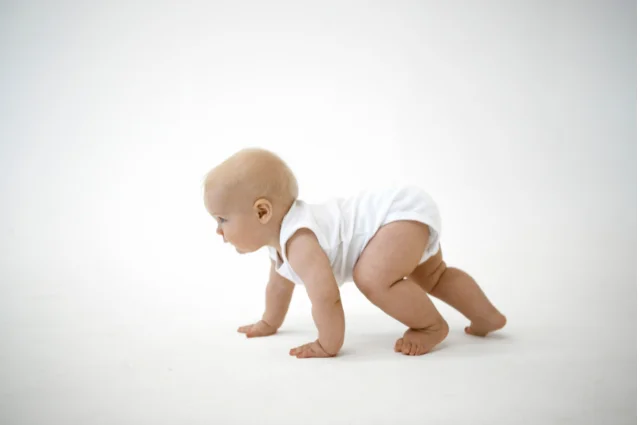Crawling is a significant milestone in the life of any baby. It is the beginning of freedom for them, as they can start to explore their world and reach out for their toys on their own. Babies usually begin crawling once they have mastered the art of holding their heads and upper bodies independently. They should also have perfected the art of sitting in one place on their own. Can a baby crawl at 4 months? Yes, it is common to see a baby crawling at 4 months once they can perfect the arts mentioned earlier.
Hey! By the way… any links on this page that lead to products on Amazon are affiliate links and I earn a commission if you make a purchase. Thanks in advance – I really appreciate it! .
5 signs baby is ready to crawl
1. Holding head without support
You know your baby is ready to crawl when they can hold their head up without support and look around. Head control is essential before your baby can attempt to crawl. That way, they won’t hit their head on the ground while moving on their hands and knees.
2. Resting on hands and knees
Another sign that your baby is ready to crawl is when they can comfortably rest on their hands and knees. They can now bear their body weight in the crawling position without rolling over or crying from pain. That is necessary so that when they eventually start to crawl, they will be able to pull their body weight along with each movement.
3. Reaching out for objects
Is your baby beginning to reach out for objects some distance from where they are sitting and even grabbing them? That is an indication that your baby will soon be crawling. Having learned to sit down for a while, they will quickly begin to get interested in the world beyond their sitting position, and they do that by conveniently grabbing things around them. With time, they will go farther distances to get their toys and other objects that interest them.
4. Coordinated hands and knees movement
You will also know that your baby will soon be crawling around the house when you see them move their hands and legs in a harmonized manner. They appear to be rehearsing a particular movement pattern. They move their hands and legs like they want to go somewhere and then return to sitting. They keep doing this for a while, like “testing the waters.”
5. Rocking on hands and knees
If your baby can rock back and forth on their hands and knees without falling over, they are ready to crawl. Doing that before now will make them fall either backward or on their face. As they gain better control of their muscles, they will make this move without harming themselves, signaling they are ready to crawl.
7 stages of crawling for babies
Babies do not begin to crawl all of a sudden. They go through different stages, each making them better in the game.
- Tummy Time: This is the first step in crawling. At this stage, babies start to develop strength in their upper body, especially the neck area, by spending time on their tummies.
- Rolling Over: Babies learn to roll over from their tummies to their backs after mastering the tummy position. They can also return to lying on their bellies from the back position.
- Rocking: Another stage of learning to crawl is when babies rock back and forth while resting on their hands and knees. They do this by holding their muscles so they don’t fall over or backward.
- Scooting: From learning to rock back and forth, babies start scooting on their bottoms. They are now developing fast on their leg and back muscles and becoming curious about what it will be like to move around from one place to the other. Objects around them start to catch their fancy, and they would want to reach out for them without your help.
- Crawling: Not long after, babies learn to move forward on their hands and knees. Yes, they start to crawl. Though slower at first, they get better with time. They usually make short trips for a start and return to their sitting position. Encouraged by this milestone, they set out to crawl increasingly amid cheers from family members.
- Cruising: As they progress with crawling, babies soon learn to pull themselves up and walk along furniture. They are beginning to see possibilities beyond moving on their hands and knees.
- Walking: Eventually, they learn to take their first steps, moving from crawling to walking. While they continue to creep even after they begin to walk, they reduce the frequency of crawling and increase walking with time.
Best surface for baby to learn to crawl
Crawling is a very delicate stage in a baby’s life. Moving around on hands and knees can be challenging when the surface is unsuitable for the child. The best surface for babies to learn to crawl is a soft and flat one. It should be soft to make them comfortable and not hurt themselves. It should also be flat to avoid them losing their balance and falling or rolling over. Examples of good and comfortable surfaces for babies to learn to crawl are floors covered with carpets and rugs. There are also play mats that are very comfortable and soft such as the Teytoy Baby cotton play mat.
Can baby crawl on the carpet?
Yes, carpet surfaces are suitable for babies to learn how to crawl. Carpets are soft and comfortable and can prevent hazardous accidents that could occur in babies that crawl on hard floors, like hitting their heads. Your baby’s hands and knees will not bruise while crawling on carpets. Also, if they should fall, the carpet will prevent them from hitting their heads and other body parts on hard surfaces, thereby preventing fractures and injuries.
Best crawling mat for babies
1. Baby foam mats for crawling
This Gimars foldable baby play mat is an excellent way for moms to protect their crawling babies from rolling over and bumping their heads while perfecting the act. It has a thickness of 0.6 inches which can cushion the effects of any fall from your baby, reducing the impact of such falls. Gimars foldable baby play mats comprise materials that are safe for your baby’s overall health. They are non-toxic and will not cause any irritation to their skin. These mats are extra-large and very suitable for them to crawl and play simultaneously. They are waterproof and effortless to clean. They are light to carry, and you can fold them when not in use.
2. Baby crawling mats with fence
Baby crawling mats with a fence is a perfect way to allow your baby to crawl all they want while keeping them in an enclave. This restriction is made possible with an about 6.5 inches high fence around the play mat. The mats are wide enough for babies to exercise their hands and legs as they can go around them as often as they want. You can also collapse the fence and lay them flat to create an even larger mat. These mats have a width of 74.5 inches. They comprise non-toxic materials, therefore not harmful to your baby. They are very easy to maintain as they wipe clean with minimal effort.
3. Baby crawling mat for hard floors
These baby play mats are suitable for hard floors. They help pad the hard floors and give your baby extra protection when they crawl or play. These mats are foldable, making them easy to store when your baby is not using them. You can also take them outdoors in their folded state so your baby is protected everywhere you go. These mats give your baby an early start with some educational designs on both surfaces. Babies can begin to learn the alphabet and identify some animals from an early age. The mats are so easy to clean that they do not retain permanent stains. With a little wipe, they are as clean as new. They are safe for your baby’s health as they contain no toxic material.
Conclusion
You may find your baby crawling at 4 months if they can control most of their body parts independently. As a loving mom, you should provide a protective play mat once you notice the baby crawling at 4 months. However, don’t fret if your baby is not crawling yet at 4 months as some babies may delay for a few more weeks before they start to crawl

